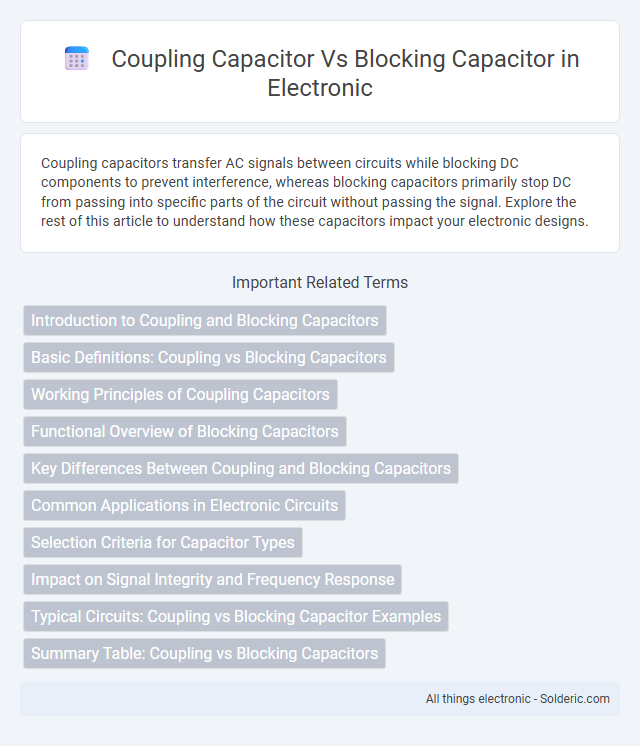Coupling capacitors transfer AC signals between circuits while blocking DC components to prevent interference, whereas blocking capacitors primarily stop DC from passing into specific parts of the circuit without passing the signal. Explore the rest of this article to understand how these capacitors impact your electronic designs.
Comparison Table
| Feature | Coupling Capacitor | Blocking Capacitor |
|---|---|---|
| Purpose | Transfers AC signals between stages while blocking DC | Blocks unwanted DC currents in circuits |
| Application | Audio amplifiers, signal processing | Power supply lines, input/output protection |
| Function | Allows AC signal flow; isolates DC bias | Prevents DC current flow; allows AC to pass |
| Placement | Between amplifier stages or components | In series with power or signal lines |
| Capacitance Range | Typically higher capacitance for low-frequency signals | Varies; often smaller to block DC effectively |
| Effect on Signal | Passes AC signals without distortion | Blocks DC, allowing AC signals to continue |
Introduction to Coupling and Blocking Capacitors
Coupling capacitors transmit AC signals between circuit stages while blocking DC components, ensuring signal integrity in amplifiers and filters. Blocking capacitors prevent DC currents from passing into unwanted parts of a circuit, protecting components and maintaining proper biasing. Your choice depends on whether AC signal transfer or DC isolation is the primary design requirement.
Basic Definitions: Coupling vs Blocking Capacitors
Coupling capacitors are used in circuits to transmit alternating current (AC) signals between different stages while blocking direct current (DC) components, preserving signal integrity. Blocking capacitors specifically prevent DC from passing through to certain parts of the circuit, protecting components and maintaining biasing conditions. Both capacitors serve critical roles in signal processing but differ primarily in their application focus--coupling capacitors facilitate signal transfer, whereas blocking capacitors restrict DC flow.
Working Principles of Coupling Capacitors
Coupling capacitors work by allowing AC signals to pass from one stage of a circuit to another while blocking DC components, effectively isolating different DC bias levels. The capacitor stores and releases energy in response to the AC signal's changing voltage, facilitating signal transfer without disturbing the operating points of active devices like transistors or amplifiers. This selective conductance is based on the capacitor's reactance, which decreases with increasing frequency, making coupling capacitors essential for maintaining signal integrity in amplifiers and audio circuits.
Functional Overview of Blocking Capacitors
Blocking capacitors serve to prevent direct current (DC) from passing while allowing alternating current (AC) signals to flow in electronic circuits, ensuring signal integrity and protecting subsequent stages from DC bias. They are crucial in amplifiers and communication devices to isolate different circuit blocks and maintain proper voltage levels. Unlike coupling capacitors that primarily transfer AC signals between stages, blocking capacitors specifically block DC components from reaching sensitive components.
Key Differences Between Coupling and Blocking Capacitors
Coupling capacitors transmit AC signals between circuit stages while blocking DC components, ensuring signal integrity without disturbing biasing conditions. Blocking capacitors specifically prevent DC from passing into sensitive parts of the circuit, protecting components from unwanted voltage, but do not primarily facilitate signal transfer. Understanding the distinct roles of these capacitors helps optimize your circuit design for signal clarity and component safety.
Common Applications in Electronic Circuits
Coupling capacitors are commonly used in audio and RF circuits to transmit AC signals between stages while blocking DC components, preserving signal integrity. Blocking capacitors are frequently employed in power supply and signal isolation applications to prevent DC current flow while allowing AC signals to pass. Your choice depends on whether the goal is signal transfer between circuit sections or prevention of DC interference.
Selection Criteria for Capacitor Types
Selection criteria for coupling capacitors involve evaluating frequency response, impedance, and voltage rating to ensure signal integrity between stages without distortion. Blocking capacitors are chosen primarily for their ability to prevent DC voltage from passing while allowing AC signals through, emphasizing dielectric material and voltage withstand capacity. Your choice depends on the specific application's need for signal transmission or DC isolation, with careful consideration of capacitance value, tolerance, and thermal stability.
Impact on Signal Integrity and Frequency Response
Coupling capacitors maintain signal integrity by allowing AC signals to pass while blocking DC components, minimizing distortion and preserving waveform fidelity, especially in audio and RF circuits. Blocking capacitors prevent unwanted DC currents from entering sensitive stages, but their value and placement can affect frequency response, potentially causing signal attenuation or phase shifts at low frequencies. Selecting proper capacitor types and values ensures your system achieves optimal frequency response and maintains signal clarity.
Typical Circuits: Coupling vs Blocking Capacitor Examples
Coupling capacitors are commonly used in audio and radio frequency circuits to transfer AC signals between stages while blocking DC components, as seen in amplifier input/output sections. Blocking capacitors, on the other hand, appear in power supply lines to prevent DC from entering sensitive parts of a circuit, such as semiconductor devices or sensitive measurement equipment. Typical examples include coupling capacitors in transistor amplifier circuits for signal integrity and blocking capacitors in signal generators or biasing circuits to isolate DC voltage levels.
Summary Table: Coupling vs Blocking Capacitors
Coupling capacitors transfer AC signals between circuit stages while blocking DC components, preserving signal integrity in amplifiers and filters. Blocking capacitors prevent DC current flow, protecting sensitive components by isolating DC voltages without affecting the AC signals. Your choice depends on whether the goal is signal transmission with DC isolation (coupling) or DC blocking with signal pass-through (blocking).
coupling capacitor vs blocking capacitor Infographic

 solderic.com
solderic.com